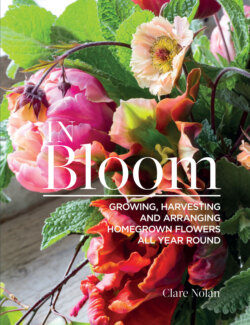Читать книгу In Bloom - Clare Nolan - Страница 8
На сайте Литреса книга снята с продажи.
ОглавлениеWhat makes a good cut flower?
The beauty of growing your own cut flowers is that you don’t have the same constraints as commercial growers: there’s no transportation involved that could damage delicate petals; no market forces dictating one color is in and another out. There’s no supplier demanding a certain stem length or blooms that last for a minimum of ten days or the worry of something not being profitable or too labor intensive. However, there are certain traits that will make one flower more appealing than another, both in terms of its performance in the garden and as a cut flower.
IN THE VASE
STEM LENGTH The longer the stem, the more versatile it is. Avoid any varieties than are labelled “compact” or “dwarf” as they may limit how you can arrange your blooms. Some short growers are still worth it for me: muscari and lily of the valley fall into this category.
LONGEVITY Some flowers simply don’t last long. Sometimes, their fleeting beauty is enough. You’ll be lucky if sweet peas are still looking good after five days, while you may only get a day from some of the most highly scented garden roses once they’ve hit full bloom. Choosing the right variety can help extend vase life.
SHEDDING
There are flowers that leave what seems like a trail of destruction in your home: the pollen from some lilies can stain furnishings or clothing when it falls; and catkins shed and deposit a thin layer of pollen dust on surfaces. Then there’s spring blossom that blooms and quickly shatters to leave a confetti-like trail through the house as you take it out to the compost bin. I still bring all of these indoors for their beauty, and the price I pay is the cleanup afterwards – only you can decide if it’s worth it.
IN THE GARDEN
It’s important to remember that you’re not creating a “garden” in the traditional sense – you’re planting to harvest the blooms and foliage. How the plants look while growing shouldn’t be your primary concern (unless of course you’re going to be planting for cutting within your existing garden borders), but it’s useful to think about how plants perform in the garden in terms of growth. How easy are they to grow? Are they resistant to disease or pests? How quick are they to get to harvest stage? How long can you cut them for? Keep these questions at the back of your mind when flicking through the catalogs.
THINK BEYOND CLASSIC “BLOOMS”
Growing your own means a whole other world of ingredients is open to you. An arching stem of glossy rosehips, an explosion of frothy grass, or a bunch of aromatic leaves are all ingredients worthy of the vase. Think like a florist and start to see anything as fair game.
A table full of early autumnal bounty, ready for one of my one-to-one classes, includes the last of the roses, precious tuberose, and zinnias with masses of seasonal foliage and fillers.
